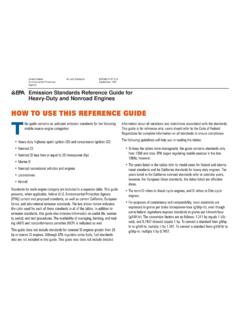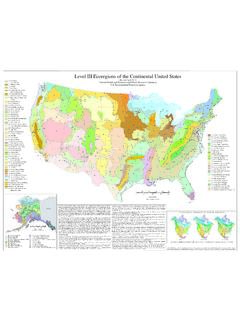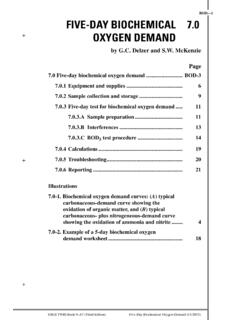Transcription of Buildings and their Impact on the Environment: A ... - US EPA
1 Buildings and their Impact on the environment : A Statistical Summary Revised April 22, 2009 Introduction While Buildings and development provide countless benefits to society, they also have significant environmental and health impacts. This summary presents some basic facts about those impacts. Footnotes provide links to the sources of this information, which offer much more context and detail on these issues. EPA s Green Building Workgroup is composed of numerous EPA programs designed to address the environmental impacts of the built environment . For more information, see EPA s Green Building website at Buildings General Statistics: General In the there were 223,114 establishments/businesses in the building industry, representing more than $531 billion in annual revenues, nearly $62 billion in annual payroll, and more than million employees in Residential Buildings Nearly 128 million residential housing units existed in the in Approximately million new housing units were built between 2005 and 2009.
2 3 Commercial Buildings Nearly million office Buildings existed in 2003 in the Every year, approximately 170,000 commercial Buildings are constructed, and nearly 44,000 commercial Buildings demolished (1995).5 1 2002 Economic Census. Census Bureau, Department of Commerce. 2 American Housing Survey for the United States- 2007. Department of Housing and Urban Development and Department of Commerce. September 2008. 3 Ibid. 4 2003 Commercial Buildings Energy Consumption Survey Overview of Commercial Buildings Characteristics. Energy Information Administration. 5 C-Series Reports. Manufacturing and Construction Division, Census Bureau, Department of Commerce. 1995. Buildings and the environment : A Statistical Summary 2 Schools Nearly 84 million Americans (including million students) spend their days in approximately 124,110 colleges, universities, public and private primary and secondary schools (2007).
3 6 Energy Use7: Buildings accounted for percent of total energy consumption in 2005. Residential Buildings accounted for percent of that total, while commercial Buildings accounted for the other percent. Buildings accounted for 72 percent of total electricity consumption in 2006 and this number will rise to 75% by 2025. 51 percent of that total was attributed to residential building use, while 49 percent was attributed to commercial building usage. The average household spends at least $2,000 a year on energy bills over half of which goes to heating and Out of the total energy consumption in an average household, 50% goes to space heating, 27% to run appliances, 19% to heat water and 4% goes to air Air and Atmosphere: Buildings in the United States contribute percent of the nation s total carbon dioxide emissions, including percent from the residential sector and percent from the commercial sector (2008).
4 10 The annual mean air temperature of a city with 1 million people or more can be F (1 3 C) warmer than its surroundings. In the evening, the difference can be as high as 22 F (12 C). Heat islands can increase summertime peak energy demand, air conditioning costs, air pollution and greenhouse gas 6 National Center for Educational Statistics- Digest Department of Education. 2007. #c1_1. 7 Buildings Energy Databook, 2006. US Department of Energy and Annual Energy Review 2007. DOE/EIA-0384 (2007). Energy Information Administration, Department of Energy. June 2008. 8 US EPA ENERGY STAR program, 9 Changes in Energy Usage in Residential Housing Units. DOE/EIA. #totcons4 10 Emissions of Greenhouse Gases in the United States 2007.
5 DOE/EIA-0573(2007). Energy Information Administration, Department of Energy. December 2008 Buildings and the environment : A Statistical Summary 3emissions, heat-related illness and One study estimates that the heat island effect is responsible for 5 10% of peak electricity demand for cooling Buildings in water Use: Building occupants use 13 percent of the total water consumed in the United States per day. Of that total, percent is used by commercial building occupants, and percent by homeowners (1995).13 Between 1950 and 2000, the population nearly doubled. However, in that same period, public demand for water more than tripled! Americans now use an average of 100 gallons of water each day enough to fill 1,600 drinking glasses14 Faucets account for more than 15 percent of indoor household water use more than 1 trillion gallons of water across the United States each year.
6 Showering accounts for approximately 17 percent of residential indoor water use in the United States more than trillion gallons of water consumed each A leaky faucet wastes gallons of water in a short period of time. A leaky toilet can waste 200 gallons per Of the 26 billion gallons of water consumed daily in the United States, approximately billion gallons, or 30 percent, is devoted to outdoor uses. The majority of this is used for landscaping. 17 The typical suburban lawn consumes 10,000 gallons of water above and beyond rainwater each Currently, about eight percent of energy demand goes to treating, pumping, and heating water and is equal to enough electricity to power more than 5 million homes for an entire year. water heating accounts for 19 percent of home energy use and 13 percent of the average utility 11 US EPA heat Island program.
7 12 Akbari, H. 2005. Energy Saving Potentials and Air Quality Benefits of Urban Heat Island Mitigation (PDF) (19 pp, 251K). Lawrence Berkeley National Laboratory. 13 Estimated water Use in the United States in 1995. Geological Survey. 14 EPA WaterSense, Why water Efficiency? 15 Information gathered from: and US EPA, WaterSense program: 16 US EPA, WaterSense program: 17 US EPA, WaterSense program: 18 US EPA, WaterSense program: 19 US EPA, Office of water : Buildings and the environment : A Statistical Summary 4 $4 billion is spent annually in the for energy to run drinking water and wastewater utilities. If this could be reduced by just 10 percent through better efficiency, that could save $400 million a Land Use: Total land area in the is billion acres.
8 Urban land area quadrupled from 1945 to 2002, increasing at about twice the rate of population growth over this period. Estimated acreage of rural land used for residential purposes increased by 21 million acres (29 percent) from 1997 to 2002 (2002).21 Indoor environment : General22 On average, Americans spend about 90 percent or more of their time indoors. Indoor levels of pollutants may be two to five times higher, and occasionally more than 100 times higher, than outdoor levels. Schools In the mid-1990s, one in five of schools reported unsatisfactory indoor air quality, and one in four schools reported ventilation as Homes In 1992, EPA estimated that nearly one out of every 15 homes had radon concentrations above the EPA recommended action Indoor Pollutants Sources of indoor air pollution may include: combustion sources; building materials and furnishings; household cleaning, maintenance, personal care, or 20 EPA ENERGY STAR for Wastewater Plants and Drinking water Systems.
9 21 US Department of Agriculture, Major Uses of Land in the United States, 2002/EIB-14, Economic Research Service/USDA. 22 The Inside Story: A Guide to Indoor Air Quality. EPA/Office of Air and Radiation. Office of Radiation and Indoor Air (6609J) Cosponsored with the Consumer Product Safety Commission, EPA 402-K-93-007. 23 Condition of America's Public School Facilities: 1999. NCES 2000 032. Department of Education, Office of Educational Research and Improvement, National Center for Education Statistics. June 2000. 24 National Residential Radon Survey: Summary Report. EPA 402-R-92-011. Environmental Protection Agency. October 1992. Buildings and the environment : A Statistical Summary 5hobby products; central heating and cooling systems and humidification devices.
10 And outdoor sources such as radon, pesticides, and outdoor air Many homes built before 1978 have lead-based paint, which can expose people to contamination through paint chips, dust and contaminated Health Effects of Indoor Environmental Quality Cancer: EPA estimates that out of a total of 146,400 lung cancer deaths nationally in 1995, 21,100 ( ) were radon Environmental tobacco smoke (also referred to as secondhand smoke) is a known human carcinogen, estimated to be responsible for approximately 3,000 lung cancer deaths in non-smokers each year as well as posing significant respiratory health risks to young children, including bronchitis, pneumonia, and Asthma: Indoor contaminants such as dust mites, molds, cockroaches, pet dander, secondhand smoke and some chemicals can trigger asthma More than 20 million people, including over 6 million children, have asthma, accounting for over 10 million outpatient clinic visits, nearly 2 million emergency department visits and nearly 4,500 deaths annually (2000).















